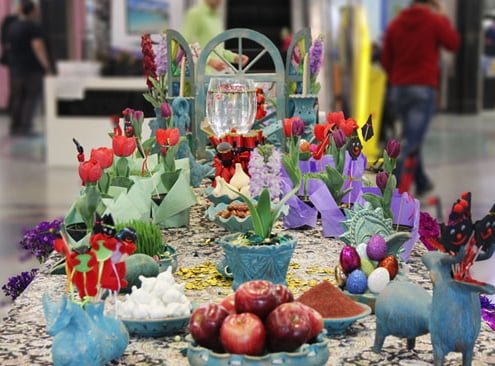Iran Nowruz Ceremonies
About Nowruz
Nowruz is the name of the Iranian New Year. Nowruz marks the first day of spring or Equinox and the beginning of the year in the Persian calendar. It is celebrated on the day of the astronomical Northward equinox, which usually occurs on March 21 or the previous/following day depending on where it is observed. The moment the sun crosses the celestial equator and equalizes night and day is calculated exactly every year and families gather together to observe the rituals.
Nowruz is celebrated by people from diverse ethnic communities and religious backgrounds for thousands of years. It is a secular holiday for most celebrants that is enjoyed by people of several different faiths, but remains a holy day for Zoroastrians. It originated in Persia in one of the capitals of the Achaemenid empire in Persis (Fars) is celebrated by the cultural regionthat came under Iranian influence.
Norooz-the-Iranian-Persian-New-Year
Before the collapse of the Soviet Union. Iran was the only country that officially observed the ceremonies of Nowruz. When the Central Asian and Caucasus countries gained independence from the Soviets, they also declared Nowruz as a national holiday. The UN’s General Assembly in 2010 recognized the International Day of Nowruz, describing it as a spring festival of Persian origin which has been celebrated for over 3,000 years. During the meeting of The Inter-governmental Committee for the Safeguarding of the Intangible Heritage of the United nations, held between 28 September – 2 October 2009, Nowrūz was officially registered on the UNESCO Liust of the Intangible Cultural Heritage of Humanity.
The festival of Nowruz is celebrated by many groups of people in the Middle East, Central and South Asia, but particularly by Persians and various other Iranian peoples. It is called Naw-wradz or Nuway-kāl by the Pashtuns, Navroz by Zoroastrians of the subcontinent, Nevruz in Turkic, Uyghurs who live in Northwestern China call it “Noruz”, and it is calledSultan Nevruz in Albanian. In Kurdish communities located in parts of western Iran, the holiday is referred to as Newroz, which is a variety of the Persian word Nowruz. The variety Nawroz is also an Eastern Persian word and is also used in the Persian speaking regions of Central Asia. In Pashto language it is pronounced as “Naw-Wraz” (New Day).
Norooz-1393
Nowruz is the most important holiday in Iran. Preparations for Nowruz begin in the month Esfand (or Espand), the last month of winter in the Persian solar calendar.
Haji Firuz is the traditional herald of Nowruz. He oversees celebrations for the new year perhaps as a remnant of the ancient Zoroastrian fire-keeper.
His face is painted black (black is an ancient Persian symbol of good luck) and wears a red costume. Then he sings and dances through the streets with tambourines and trumpets spreading good cheer and heralds the coming of the New Year.
Nowruz Tour
Day 1:
Arrival in Tehran, meet and greet at the airport & transfer to hotel. Having lunch in an exquisite traditional Iranian restaurant, and Visiting Crown Jewels Museum.
Attention: The priority in sightseeing may be changed due to the time of your arrival, preference of your guide and also official and unofficial holidays of some museums.
Day 2:
In the morning full day city tour of Tehran includes visiting Archeological & Islamic Museums, Sa’ad Abad Complex, and Milad Tower. Flight to Shiraz.
Day 3:
A full day city tour of Shiraz includes visiting Vakil Bazaar, Hamam-e-Vakil, Vakil mosque, Karim Khan palace, and Nasir Almolk mosque. And in the afternoon the tour continues visiting Eram garden, Hafez tomb, Sa’di tomb, Khajooye Kermani and Qoran gate.
Day 4:
In the morning an excursion to the great monuments of Iran: Persepolis, Naghsh-e-Rostam (Necropolis) & Naghsh-e-Rajab then leave for Isfahan.
Day 5:
A full day city tour of Isfahan includes visiting Imam Square (Naqsh-e-Jahan), the architectural marvels of Sheikh Lotfollah and Imam Mosques, Aliqapu Palace, Chehel Sutoon, and Hasht Behesht Palaces. Stay overnight in Isfahan.
Day 6:
The city tour continues visiting Isfahan’s Jame’ mosque, Vank Church, Monar Jomban, the tomb of a Sufi with its shaking minarets and some historical bridges.
Day 7:
Driving to Kashan. On the way to Kashan, we will visit Abyaneh, Tabatabaiha and Borojerdiha houses. Stay overnight in Kashan.
Day 8:
Transfer to IKA, in rout visiting the Holy Shrine of Hadhrat Ma’soumeh in Qom, and departure.






